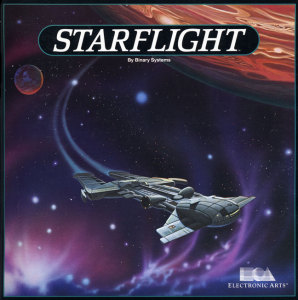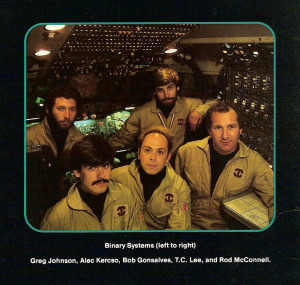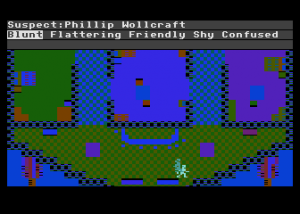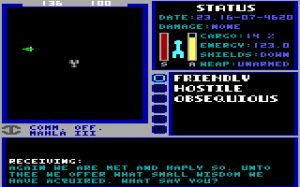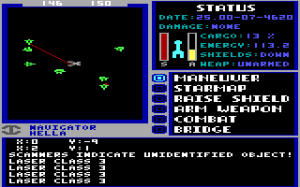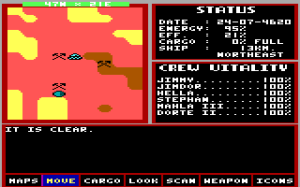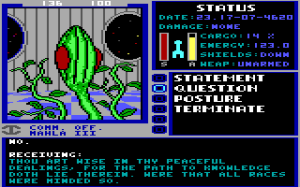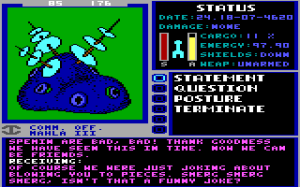Fair warning: this article spoils the ending to Starflight, although it doesn’t spoil the things you need to know to get there.
Starflight, one of the grandest and most expansive games of the 1980s, was born in the cramped confines of a racquetball court. Rod McConnell, a businessman who had been kicking around Silicon Valley for some years, happened to have as his regular playing partner Joe Ybarra, a former Apple executive who in late 1982 had decamped to join Trip Hawkins’s fledgling new Electronic Arts as a game “producer.” Intrigued by Ybarra’s stories of “electronic artists” and an upcoming revolution in entertainment based on interactivity, McConnell wondered if he might somehow join the fun. He thus started discussing ideas with a programmer named Dave Boulton.
Boulton, who died in 2009, is the unsung hero of Starflight. His involvement with the project wouldn’t last very long, but his fingerprints are all over the finished game. He was, first and foremost, a zealot for the Forth programming language. He was one of the founding members of the Forth Interest Group, which was established just at the beginning of the PC era in 1977 and did stellar work to standardize the language and bring it to virtually every one of the bewildering variety of computers available by the early 1980s. More recently his hacking had led him to begin exploring the strange universe of Benoit Mandelbrot’s fractal sets fully eighteen months before Rescue on Fractalus! would make fractals a household name for gamers and programmers everywhere. Boulton enticed McConnell with an idea much bigger than Lucasfilm’s simple action game: an almost infinitely vast planet which, thanks to the miracle of fractals, the player could roam at will.
McConnell founded a company named Ambient Design and hired a couple of young programmers to help Boulton. One, Alec Kercso, was just finishing a degree in Linguistics in San Diego, but was more interested in his hobby of hacking. The other, Bob Gonsalves, was another dedicated Forther who wrote a monthly column on the language for Antic magazine. He was hired on the basis of this as well as his intimate familiarity with the Atari 8-bit platform, which thanks to its audiovisual capabilities was the great favorite around EA circles during that first year or so, until the Commodore 64 came online in earnest. On the strength of McConnell’s friendship with Ybarra and little else — the whole group of them had among them neither any experience with game development nor any real plan for what their game would be beyond a vast environment created with fractals — EA signed them as one of the first of their second wave of contracts, following the premiere of the initial six, reputation-establishing EA games. Ybarra would be their producer, their main point of contact with and advocate within EA. He would have his work cut out for him in the years to come.
The idea soon evolved to encompass not just a single planet but many. The game, to be called Starquest, would let you fly in your starship across an entire galaxy of star systems, each with planets of its own, each of which would in turn be its own unique world, with unique terrain, weather, life forms, and natural resources. For Boulton, the man who had gotten this ball rolling in earnest in the first place, it was suddenly getting to be too much. You just couldn’t do all that on an 8-bit computer, he said, not even with the magic combination of Forth and fractals. He walked away. He would go on to develop early software for the Commodore Amiga and to join another unheralded founder, Jef Raskin of the original vision for the Apple Macintosh, to work on Raskin’s innovative but unsuccessful Canon Cat.
Left on their own with only Boulton’s prototype fractal code to guide them, Kercso and Gonsalves felt over their heads. They needed to be able to show each planet as a rotating globe from space, complete with the fractal terrain that the player would be able to explore more intimately if she elected to land, but didn’t know how to map the terrain onto a sphere. McConnell soon found another programmer, Tim Lee, who did. Lee had already written firmware for Texas Instruments calculators and written very complex policy-analysis applications for life-insurance companies. Yet another Forth fan, he’d just finished writing an actual game in the language, an IBM PC port of the Datasoft action game Genesis which Datasoft would never ship due to its incompatibility with the PCjr. With the graphics code he’d developed for that project, plus his own explorations of fractal programming, Lee was more than up to rendering those spinning terrain-mapped globes.
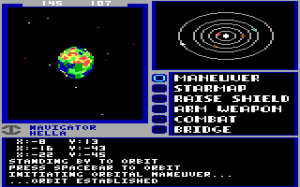
One of Tim Lee’s spinning terrain-mapped planets. He was also responsible for most of the fundamental low-level architecture of the game.
Lee also brought with him his programming expertise on the IBM PC. This prompted the team to take a big step: to abandon their little 8-bitters and move to the bigger 16-bit MS-DOS machines. They had recognized that Boulton had been right: their ideas were just too big to fit into 8 bits. MS-DOS was just finishing up its trouncing of CP/M to become undisputed king of the business-computing world, but had managed little penetration into homes, which were still dominated by the likes of the Apple II and Commodore 64. On the one hand, the IBM was a terrible gaming platform: its CGA graphics could show only four colors at a time in palettes that seemed deliberately chosen to clash as horribly with one another as possible and give artists nightmares; its single speaker was capable of little more than equally unpleasant bleeps and farts; even standard gaming equipment like joysticks were effectively non-existent due to a perceived lack of demand. But on the other hand, the IBM was an amazing gaming platform, with several times the raw processing power of the 8-bitters and at least twice the memory. Like so much in life, it all depended on how you looked at it. Ambient Design decided they needed the platform’s advantages to contain a galaxy that would eventually encompass 270 star systems with 811 planets between them, and they’d just have to take the bitter with the sweet. Still, it’s unlikely that EA would have gone along with the idea had it not been for the imminent release of the PCjr, which was widely expected to do in home computing what its big brother had in business computing.
About this point the last and arguably biggest piece of the development puzzle arrived in the form of Greg Johnson, Kercso’s roommate. Not much of a programmer himself, Johnson had, like his roommate, also just finished a degree and wasn’t quite sure what to do next. He had listened avidly to Kercso’s reports on the game’s progress, and eventually started drawing pictures of imagined scenes on his Atari 800 just for fun. He was soon coming up with so many pictures and, more importantly, ideas that Kercso got him an interview and McConnell hired him. Just like that, Johnson became the much-needed lead designer. Until now the team had been focused entirely on the environment they were trying to create, giving little thought to what the player would be expected to actually do there. As Kercso would later put it, what had been an “open-ended game of exploration” now slowly began to evolve into “a complex story with interwoven plots and twists.” Johnson himself later said his job became to come up with what should happen, the others to come up with how it could happen. Or, as Lee put it, Johnson designed the scenario while the others designed “the game system that you could write the scenario for.” And indeed, he proved to be a boundless fount of creativity, coming up with seven unique and occasionally hilarious alien races for the player to fight, trade, and converse with during her travels.
Critical to those conversations became a designer we’ve met before on this blog, Paul Reiche III, who spent two important weeks helping Johnson and his colleagues to hash out a workable conversation engine which made use of the system of conversation “postures” from a game he had co-designed with Jon Freeman, Murder on the Zinderneuf. Reiche, an experienced designer of tabletop RPG rules and adventures as well computer games, continued to offer Johnson, who had heretofore thought of himself as a better artist than writer or designer, advice and ideas throughout the game’s protracted development.
“Protracted” is perhaps putting it too mildly. The process just seemed to go on forever, so much so that it became something of a sick running joke inside EA. The project appeared on more than three years worth of weekly status reports, from the time that EA was mature enough to have weekly status reports until the game’s belated release in August of 1986. Over that time the arcades and home game consoles crashed and burned; the home-computer industry went through its own dramatic boom and bust and stabilization; countless platforms came and went, not least among them the PCjr; EA gave up on the dream of revolutionizing mainstream home-entertainment and accepted the status of big fish in the relatively small pond of computer gaming; IBM achieved business-computing domination and then ceded it almost as quickly thanks to the cloners; the bookware craze came and went; Infocom rose to dizzying heights and crashed to earth just as quickly; the Soviet Union went from an Evil Empire to a partner in nuclear-arms control. And still, ever and anon, there was Starflight, the much more elegant name chosen for Starquest after the release of Sierra’s King’s Quest. McConnell’s company name changed as well before all was said and done, from Ambient Design to Binary Systems (get it?).
EA very nearly lost patience several times; McConnell credits his old friend Joe Ybarra with personally rescuing the project from cancellation on a number of occasions. With the contract structured to provide payments only after milestones that were few and increasingly far between, McConnell himself took personal loans and worked other jobs so as to be able to pay his team a pittance. Throughout it all he never lost faith, despite ample evidence that they didn’t, to be painfully blunt, entirely know what they were doing. The team members lived on savings or loans when their meager salaries ran out. Many months were consumed by fruitless wheel-spinning. As Lee later admitted, they were so entranced with this model universe that they “spent a lot of time trying to model things that didn’t add to the play of the game.” Forth was never the most readable language nor an ideal choice for a large group project, and as the project wandered off in this or that direction and back again the code got nightmarishly gnarly. This just made trying to modify or add to it take still longer. With McConnell only able to afford a tiny office and most of the team thus working remotely most of the time, just keeping everyone on the same page was difficult. Given the situation and the personalities involved, a certain amount of freelancing was inevitable. “There was no master plan detailing each and every task to be done,” said Kercso later. “We had an idea of what the major modules had to be and we added a lot of final design as we got into programming each of the modules”; then they did their best to mash it all together.
Starflight was a prototypical runaway, mismanaged, overambitious project, the likes of which the industry has seen many times since. The difference was, instead of being ignominiously cancelled or shoved out the door incomplete, Starflight somehow ended up amazing. Call it serendipity, or credit it to a team that just wouldn’t give up. Once the core group was assembled, nobody thought of quitting; everyone was determined to finish the game — and on its own original, insanely ambitious terms at that — or die trying. “I remember saying that I didn’t care if I died after it came out,” said Johnson later, but “please, God, let me live until then.”
Some of the confusion and occasional lack of direction is visible in the final game. Even the biggest Starflight fan would have trouble praising the arcade-style in-space combat engine, for instance, which manages to be both far too simplistic and far too baffling to actually control. There’s a disconnected feeling to certain elements, as of clever ideas that were never fully woven into the holistic design. You can gather flora and fauna from the planets you visit and return them to your base to study, for example, but you make so little money from doing so as opposed to mining minerals — and the controls for stunning and gathering your specimens are once again so awkward — that you’re left wondering what the point is. Ditto most of the intriguing alien artifacts you find, which you cart excitedly back to base only to find that they “reveal very little of interest” and are “totally useless to us.” And the game has what should be a fatal case of split personality, being half stately space opera and half silly romp filled with sci-fi alien caricatures.
And yet it really doesn’t matter. Starflight is that rare piece of work that actually justifies the critic’s cliché of being more than the sum of its parts. It’s not a tight design; appropriately given its theme, it sprawls everywhere, sometimes seemingly uselessly so. But even its blind alleys are fascinating to wander down once or twice. It’s the opposite of a minimalist masterpiece like M.U.L.E., whose every last note is carefully considered and exhaustively tested and blended carefully into the whole. And you know what? It’s every bit as awesome.
But for the benefit of those of you who haven’t played it it’s really high time that I tell what the game’s all about, isn’t it?
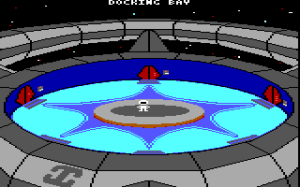
Your home starbase, where you outfit your ship, select and train your crew, buy and sell equipment and resources, etc. It was largely the work of Alec Kercso.
Starflight starts you off at your base on your home planet of Arth — no, that’s not a typo — with a rather shabbily equipped ship and a little bit of seed capital. If you’re smart, you’ll spend most of the latter training a crew, which will include, in the tradition of a certain classic television series that went where no man has gone before, a Captain, a Science Officer, a Navigator, an Engineer, a Communications Officer, and a Doctor. You’ll also need to save enough to add a cargo pod or three to your ship, so you can begin to earn money by landing on nearby planets and scooping up minerals for sale back at Arth. You need money to upgrade your ship with better engines, weapons, and defenses, to train your crew, and to buy something called endurium, if you can’t find or mine enough of it. Endurium is Starflight‘s equivalent to dilithium crystals, the semi-magical fuel that enables faster-than-light travel.
As you build up your ship and your bank account, you can travel ever farther from Arth, exploring an algorithmically generated galaxy so vast that, like the Fibonacci galaxies of Elite, even Starflight‘s creators hadn’t seen all of it before the game’s release. And so you fly and land where you will, searching for mineral-rich planets you can mine and, even better, habitable planets you can recommend for colonization; you receive a substantial finder’s fee in return for each recommendation. Alien races inhabit various sectors of the galaxy. Some you may be able to befriend, or at least achieve a level of mutual toleration with; others you’ll have to fight. Thus the need to fit out your ship with the best possible weapons and defenses.
This, then, is Starflight the sandbox game. While it’s in no way derivative of Elite — Starflight‘s creators couldn’t have even been aware of the older game until quite late in their own development cycle, since Elite didn’t reach American shores until late 1985 — Starflight does generate a similar compulsion to explore, an addictive need to see what all is out there. But everything about Starflight is richer and more complex, with the exception only of the combat system that was the heart of Elite but a mere afterthought in Starflight (if you had to spend much time in Starflight actually fighting, it would be a very, very bad game). With so much more computing horsepower at their disposal, Binary Systems was able to add layer after intriguing layer: the ability to land on planets, and once there to engage in an exploring and mining mini-game that is as absurdly addictive as it is superficially simplistic; the chance to converse with the aliens you meet instead of just shooting at them; the whole CRPG angle of training a crew and keeping them healthy; sensor- and Navigator-confounding nebulae and wormholes to negotiate. Whereas Elite sessions soon settle down into a comfortable routine of trade-jump-fight-dock, rinse and repeat forever, Starflight always seems to have something new to throw at you.
But the most important difference is the plot that Starflight layers over its sandbox. I realize everyone is different on this point, but personally I always have a little bit of trouble with purely open-ended games (see my review of Seven Cities of Gold for another example). When I play Elite I eventually start to get bored for lack of any real narrative or goal to shoot for beyond the almost impossible one of actually becoming Elite. Ian Bell and David Braben originally wanted to include a real plot, but there just wasn’t room to contain it inside a 32 K BBC Micro. Starflight, however, has the sort of plot-driven direction that Elite so painfully lacks.
So, having told you what you can do in Starflight, let me now tell you why you do it. Evidence has recently turned up on Arth that the planet’s inhabitants did not evolve there; that it was colonized at some point in the distant past, that the colonists regressed into barbarism due to war or other pressures, and that only now has civilization recovered. A cache of old documents has also revealed the secrets of endurium and faster-than-light travel. All of which is great, except that Arth has even bigger fish to fry. A strange wave is spreading across the galaxy, causing stars to flare — with disastrous results for any orbiting planets — as it strikes them. Thus your mission is not just to explore and get rich, but to discover the source of the wave and to stop it before it reaches Arth.
Starflight has an unusually elaborate plot for its day, but unlike in so many more recent games it never straitjackets you to it. The plot is more backstory than story. The game is essentially a big scavenger hunt, sending you off to reconstruct quite a complicated galactic history. Follow the trail long enough and you should turn up the clues and objects you need to end the threat to Arth and the galaxy by blowing up a certain Crystal Planet that’s the source of all the trouble. There’s not all that much that you actually need to do to beat the game when you know how. In fact, you can do it in less than two game days. It’s the clue- and object-scavenging that’s all the fun, the process of putting the pieces of the backstory together. When you discover Earth, for example — yes, those original colonizers of Arth came, inevitably, from Earth — it gives a thrill when you first look down on those familiar continents from orbit. Other pieces of the puzzle are almost equally thrilling when they come to light. If you’re playing cold, sans walkthrough — which is honestly the only way to play; you’ll otherwise just be left wondering what all the fuss is about — you’ll need to look everywhere for clues: to the occasional emails you receive from your overseers on Arth; to messages and artifacts you find on the planets; to the map and other materials included in the game package. And, most importantly, you need to talk at length to all those aliens, a goofy and amusing rogue’s gallery of sci-fi clichés. They’re the silly part of this odd mixture of stately epic and silly romp — but they’re so much fun we’ll take them just as they are, cognitive dissonance be damned.
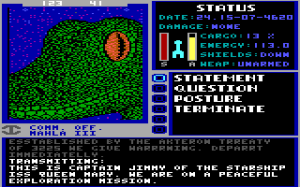
The Thrynn, who have such weird issues with the Elowan that they’ll attack if you have one in your crew.
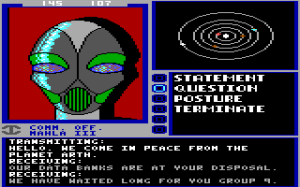
The Mechans, a group of robots who think you’re just what they’ve been waiting for all these millennia.
Now, this plot-as-scavenger-hunt approach to gameplay is hardly an innovation of Starflight. The Ultima games in particular had long been trolling these waters by the time it appeared. The breadcrumb-following approach to game design always gives rise to the possibility of getting yourself stuck because you’ve missed that one little thing in this absurdly vast virtual world on which all further progress depends. Yet there is a difference between Starflight and Ultima in this respect, a difference not so much in kind as in quality. Starflight is a much more friendly, generous game. Whereas Ultima seems to relish making you fail by hiding vital clues in the most outlandish places or behind the most unlikely parser keywords, there’s a sense that Starflight really wants you to succeed, wants you to solve the mystery and save the galaxy. There are multiple ways to learn much of what you need to know, multiple copies of some vital artifacts hidden in completely different places, multiple solutions to most of the logistic and diplomatic puzzles it sets before you. Yes, there’s a time limit, what with Arth’s sun destined eventually to flare, but even that is very generous, operating more as a way to lend the game excitement and narrative urgency than a way to crush you for failing some hardcore gamer test. Its generosity is not absolute: in my own recent playthrough I had to turn to a walkthrough to learn that you need to be obsequious when you talk to the Velox or they’ll never share an absolutely vital piece of information that I don’t think you can glean anywhere else (remember that, would-be future players!). Still, even these few choke points feel more like accidents than deliberate cruelties strewn in your path by cackling designers. Starflight really does feel like a welcome step toward a more forgiving, inclusive sort of gaming.
Spoilers begin!
No discussion of Starflight‘s plot can be complete without the shocker of an ending. When you finally arrive at the Crystal Planet and are preparing to destroy it, everything suddenly gets deeply weird via a message from an earlier visitor:
I can hardly believe it! Those weird lumps are actually intelligent life. The Ancients are endurium! And we have spent hundreds of years hunting them to burn for fuel in our ships. Their metabolism is so much slower than ours that they live in an entirely different time framework. I don’t think they even know we are sentient. I believe it was only because of a link thru the Crystal Planet that contact was made at all. This Crystal Planet was their last defense. I can hardly blame them. Carbon-based life must have seemed something like a virus to them.
Despite this discovery, the only option — other than to simply stop playing — is to blow up the Crystal Planet anyway, thus annihilating the home planet of a race much more ancient and presumably more sophisticated than your own. It’s a strange, discordant sort of ending to say the least. Some have made much of it indeed; see for instance an earnest article in Envirogamer that would make of Starflight an elaborate allegory for our environmental problems of today, with endurium representing fossil fuels and the stellar wave standing in for global warming. I’m not really buying that. Not only does the article strike me as anachronistic, an argument born of 2009 rather than the mid-1980s, but I somehow have trouble seeing Starflight as a platform for such deliberate messaging; it strikes me as a grand escapist space opera, full stop, without any rhetorical axe to grind.
But is Starflight‘s ending a deliberate subversion of genre convention, like the controversial ending to Infidel? Maybe. It’s not as if the game is not without a certain melancholia in other places; for instance, you’ll occasionally meet a race of interstellar minstrels who roam the spacelanes singing sad songs about glories that used to be. Yet after you do the bloody deed on the Crystal Planet the game immediately leaps back to unabashed triumphalism, gifting you with medals and music and glory and a chance to roam the galaxy at your leisure with an extra 500,000 credits in your account, burning genocidal quantities of endurium as you do so with nary a moral qualm to dog your steps. What to make of this seeming obliviousness to the ramifications of what you’ve just done? You’ll have to decide for yourself whether it represents subtlety or just a muddle of mixed messages that got away from their creators. It’s just one more of the layers within layers that make Starflight so memorable for just about everyone who plays it.
Spoilers end!
In addition to its innovations in the softer arts of design and narrative, Starflight has one final, more concrete quality that sets it apart from what came before, one that can be very easy to overlook but is nevertheless of huge importance. It’s the first of these big open-world games that offers a truly persistent virtual world to explore. Due to the limitations of 8-bit floppy-disk drives, earlier games all fudge persistence in some way. The Wizardry and Bard’s Tale games, for instance, save only the state of your characters between sessions. Everything else resets to its original state as soon as you leave the game, or, indeed, just travel between dungeon levels or between the dungeon and the city. Amongst numerous other oddities, this means that you can actually “win” these games over and over with the same group of characters; the games literally forget you’ve done so almost immediately after showing you the victory screen. The 8-bit Ultimas do only a little better: the outdoor world map does persist along with the details of your characters, but cities and dungeons, again, reset themselves ad infinitum. You can go into a town, murder a dozen guards and rob every shop in town, then exit and return to find all restored to peace and tranquility again. Indeed, solving the early Ultimas is virtually dependent on you doing exactly this.
Starflight, however, is different. Its whole vast galaxy remembers what you have done, on both a macro- and micro-scale. If you discover a juicy new planet, name it, and recommend it for colonization, it goes by that name for the rest of the game. If you befriend or piss off a given alien race, they don’t forget you or what you’ve done. If you strip-mine a planet of all its minerals, they don’t reappear the next time you land on it. If you make notes in your “Captain’s Log” (a first in itself), they remain there until you delete them. If you blow up an alien race’s home planet thereby destroying their entire civilization, it stays blown up. This is a huge step forward for verisimilitude, one enabled by Binary Systems’s choice to throw caution to the wind and target the bigger, more capable MS-DOS machines. [1]This is not to say that all is smooth sailing. Starflight constantly saves updated versions of its data files to disk as you play. It then relies on you to “commit” all of these changes by cleanly exiting the game from the menu. If you ever exit without properly saving, or get killed, your game becomes unplayable until you reset it back to its original data — whereupon you have the joy of starting all over. My advice is to make backups of the files “STARA.COM” and “STARB.COM” after every successful session; then if you get killed or have some other problem you can just copy these back into the game’s directory to get back to a good state. Or, if you like, here’s a DOSBox startup script you can use to automatically keep a few generations of states. Just copy it into the “[autoexec]” section of the game’s “.conf” file, editing as needed to suit your directory names.
As Starflight neared release at last, it was very much an open question whether it would find an audience. By now the PCjr had come and gone — just as well given that the game’s memory requirements had ballooned past that machine’s standard 128 K to a full 256 K. No one had ever released such a major title exclusively on MS-DOS. Normally if that platform got games at all they were ports of titles that had already proved themselves on the more popular gaming machines, delivered months or years after their debuts elsewhere. Binary Systems and EA could only make sure Starflight supported the popular Tandy 1000’s enhanced graphics and hope for the best.
The best was far better than they had bargained for: initial sales far exceeded the most optimistic expectations, leaving EA scrambling to produce more copies to fill empty store shelves. It would eventually sell well over 100,000 copies on MS-DOS alone, a major hit by the standards of any platform. Starflight placed owners of other computers in the unaccustomed position of lusting after a game on MS-DOS of all places, a platform most had heretofore viewed with contempt. Appearing as it did even as owners of the new generation of 68000-based machines were reveling in their Macs, Amigas, and Atari STs, Starflight was an early sign of a sea change that would all but sweep those platforms into oblivion within five years or so. With it now clear that a market of eager MS-DOS gamers existed, the platform suddenly became a viable first-release choice for publishers and developers. Only years later would Starflight belatedly, and not without much pain given the unique Forthian nature of its underpinnings, be ported to the Amiga, ST, Macintosh, Sega Genesis, and even the little Commodore 64 — the latter of which would probably have been better bypassed. It would sell at least 200,000 more copies on those platforms, a nice instance of creativity and sheer hard work being amply rewarded for Rod McConnell’s idealistic little team of five.
Most of Binary Systems stayed together long enough to craft a fairly workmanlike sequel, Starflight 2: Trade Routes of the Cloud Nebula, released in 1989 for MS-DOS just as the first ports of the original game were reaching those other platforms. It was playable enough, but somehow lacked some of the magic of the original. Most then drifted away from the games industry, with only Greg Johnson continuing to work intermittently as a designer, most notably of the Toejam & Earl games for the Sega Genesis. Starflight had been such an all-consuming, exhausting labor of love that perhaps it was hard for the others to imagine starting all over again on another, inevitably less special project. Making Starflight had been the sort of experience that can come only once in a lifetime; anything else they did in games afterward would have been anticlimactic.
If we’re looking for something to which to attribute Starflight‘s success, both commercially and, more importantly, artistically, we’re fairly spoiled for choice. Alec Kercso credits the way that he and his colleagues were allowed to work “organically,” experimenting to see what worked and what didn’t. Credit also the odd idealism that clung to the team as a whole, which prompted them to never back away from their determination to make something bigger and qualitatively different than anything that had come before, no matter how long it took. Credit Joe Ybarra and the management of EA who, skeptical as they may sometimes have been, ultimately gave Binary Systems the time and space they needed to create a masterpiece. Credit Rod McConnell for giving his stable of talented youngsters the freedom to create whilst finding a way to keep the lights on through all those long years. And credit, almost paradoxically, the limited technology of the era. With their graphics capabilities sharply limited, the team was free to concentrate on building an interesting galaxy, full of interesting things to do, and to tweak it endlessly, without needing to employ dozens of artists and 3D modellers to represent every little idea; tellingly, the only artist on the team was Johnson, who was also the lead designer. And of course credit Johnson for giving the game a plot and an unforgettable, quirky personality all its own, without which all of its technical innovations would have added up to little.
There’s a stately dignity to Starflight even amidst all the goofy gags, a sense of something grand and fresh and new attempted and, even more remarkably, actually realized. Few games have ever captured that science-fictional sense of wonder quite this well. If you start playing it — and that’s very easy to do now; Starflight 1 and 2 are both available in one-click-installable form from GOG.com — you might just find yourself lost in its depths for a long, long time. This, my friends, is one of the great ones.
(Useful vintage articles on Starflight include an interview with Rod McConnell in the March 1987 Computer Gaming World and especially one with Tim Lee in the July/August 1987 Forth Dimensions. Alec Kercso wrote about the game in, of all places, Jonathan S. Harbour’s Microsoft Visual BASIC Programming with DirectX. Good recent articles include ones in The Escapist, Gamasutra, and Sega-16. Tim Lee gave part of the source code and many design documents to Ryan Lindeman. He once made even more source and documents available online, some of which can still be recovered via the Internet Archive’s Wayback Machine. Similarly available only via the Wayback Machine is Miguel Etto’s technical analysis of the game’s Forthian underpinnings. See The CRPG Addict for an experiential play-through of the game.)
Footnotes
| ↑1 | This is not to say that all is smooth sailing. Starflight constantly saves updated versions of its data files to disk as you play. It then relies on you to “commit” all of these changes by cleanly exiting the game from the menu. If you ever exit without properly saving, or get killed, your game becomes unplayable until you reset it back to its original data — whereupon you have the joy of starting all over. My advice is to make backups of the files “STARA.COM” and “STARB.COM” after every successful session; then if you get killed or have some other problem you can just copy these back into the game’s directory to get back to a good state. Or, if you like, here’s a DOSBox startup script you can use to automatically keep a few generations of states. Just copy it into the “[autoexec]” section of the game’s “.conf” file, editing as needed to suit your directory names. |
|---|
